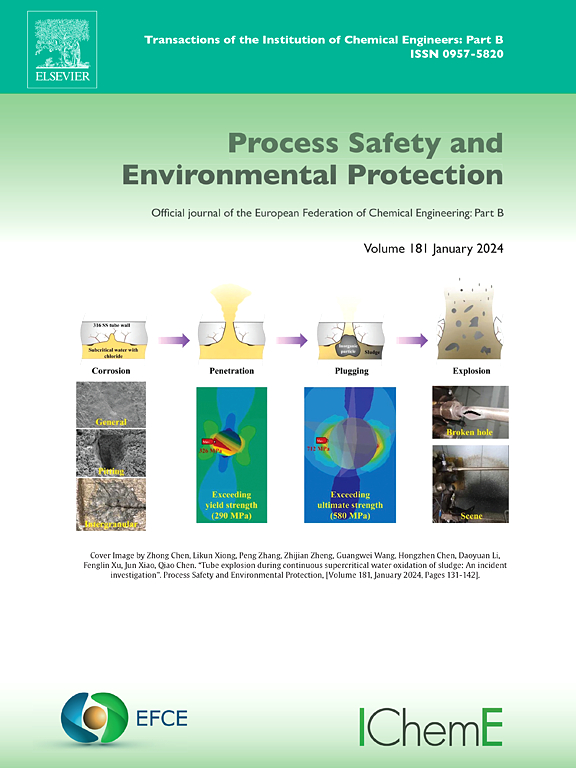甲醇驱动下紫外光解深度还原硝酸盐和2,4,6-三溴苯酚
IF 6.9
2区 环境科学与生态学
Q1 ENGINEERING, CHEMICAL
引用次数: 0
摘要
近年来,基于有机自由基的高级还原技术越来越受到人们的关注。本研究利用甲醇作为有机添加剂对NO₃⁻进行光解,构建了一种新的ARP,以增强紫外线照射下NO₃⁻和2,4,6-三溴苯酚(2,4,6- tbp)的还原去除作用。结果表明,在pH值为10的情况下,甲醇可以显著改善NO₃⁻还原(97.8% %)和2,4,6- tbp⁻还原(97.1 %)。然而,过量的2,4,6- tbp(2 mM)会降低光穿透,降低系统效率。腐殖酸、Cl - 4和CO₃²对去除2,4,6- tbp的影响最小,但对3 - 3的作用有抑制作用。溶解氧(DO)在封闭系统中由于耗竭迅速,影响可以忽略不计。电子顺磁共振(EPR)证实了•OH和•CH₂OH自由基的形成,它们驱动双重氧化还原途径。虽然一些中间体表现出毒性,但总体出水毒性降低了33% %。这项研究的结果挑战了甲醇在高级氧化过程中的作用的传统观点,并提出了一种潜在的还原性消除污染物的新方法。本文章由计算机程序翻译,如有差异,请以英文原文为准。
Methanol-driven advanced reduction of nitrate and 2,4,6-tribromophenol by UV-activated photolysis
Organic radicals-based advanced reduction processes (ARPs) have gained increasing attention in recent years. This study constructs a novel ARP leveraging NO₃⁻ photolysis with methanol as an organic additive to enhance the reductive removal of NO₃⁻ and 2,4,6-tribromophenol (2,4,6-TBP) under UV irradiation. Results demonstrate that methanol significantly improves NO₃⁻ reduction (97.8 %) and 2,4,6-TBP debromination (97.1 %) at pH 10. However, excessive 2,4,6-TBP (2 mM) reduces light penetration, diminishing system efficiency. Humic acid, Cl⁻, and CO₃²⁻ minimally affect 2,4,6-TBP removal but inhibit debromination and NO₃⁻ reduction. Dissolved oxygen (DO) shows negligible impact in closed systems due to rapid depletion. Electron paramagnetic resonance (EPR) confirms the formation of •OH and •CH₂OH radicals, which drive dual oxidation-reduction pathways. While some intermediates exhibit toxicity, the overall effluent toxicity decreases by 33 %. The findings of this study challenge conventional perspectives on methanol's role in advanced oxidation processes and suggest a potential novel approach for the reductive elimination of pollutants.
求助全文
通过发布文献求助,成功后即可免费获取论文全文。
去求助
来源期刊

Process Safety and Environmental Protection
环境科学-工程:化工
CiteScore
11.40
自引率
15.40%
发文量
929
审稿时长
8.0 months
期刊介绍:
The Process Safety and Environmental Protection (PSEP) journal is a leading international publication that focuses on the publication of high-quality, original research papers in the field of engineering, specifically those related to the safety of industrial processes and environmental protection. The journal encourages submissions that present new developments in safety and environmental aspects, particularly those that show how research findings can be applied in process engineering design and practice.
PSEP is particularly interested in research that brings fresh perspectives to established engineering principles, identifies unsolved problems, or suggests directions for future research. The journal also values contributions that push the boundaries of traditional engineering and welcomes multidisciplinary papers.
PSEP's articles are abstracted and indexed by a range of databases and services, which helps to ensure that the journal's research is accessible and recognized in the academic and professional communities. These databases include ANTE, Chemical Abstracts, Chemical Hazards in Industry, Current Contents, Elsevier Engineering Information database, Pascal Francis, Web of Science, Scopus, Engineering Information Database EnCompass LIT (Elsevier), and INSPEC. This wide coverage facilitates the dissemination of the journal's content to a global audience interested in process safety and environmental engineering.
 求助内容:
求助内容: 应助结果提醒方式:
应助结果提醒方式:


